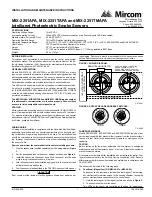
MC-400-006 1 I56-3319-000
MIX-2251APA, MIX-2251TAPA and MIX-2251TMAPA
Intelligent Photoelectric Smoke Sensors
INSTALLATION AND MAINTENANCE INSTRUCTIONS
BEfORE INSTALLINg
This sensor must be installed in compliance with the control panel system
installation manual. The installation must meet the requirements of the Au-
thority Having Jurisdiction (AHJ). Sensors offer maximum performance when
installed in compliance with CAN/ULC-S524.
gENERAL DESCRIPTION
Models MIX-2251APA, MIX-2251TAPA and MIX-2251TMAPA are plug-in
type smoke sensors that combine a photoelectronic sensing chamber with
addressable-analog communications. The sensors transmit an analog rep-
resentation of smoke density over a communication line to a control panel.
Rotary-decade switches are provided for setting the sensor’s address.
Two LEDs on the sensor are controlled by the panel to indicate sensor status.
An output is provided for connection to an optional remote LED annuncia-
tor (P/N RA400ZA/RA100ZA). Models MIX-2251TAPA and MIX-2251TMAPA
combine a photoelectronic sensing chamber and 135°F (57.2°C) fixed tem-
perature heat detector.
The MIX-2251APA, MIX-2251TAPA and MIX-2251TMAPA require compat-
ible addressable communications to function properly. Connect these
sensors to listed-compatible control panels only.
SPACINg
Mircom recommends spacing sensors in compliance with CAN/ULC-S524. In
low air flow applications with smooth ceilings, space sensors 30 feet apart.
For specific information regarding sensor spacing, placement, and special
applications, refer to CAN/ULC-S524 or the System Smoke Detector Applica-
tion Guide, available from Mircom.
WIRINg gUIDE
All wiring must be installed in compliance with the Canadian Electrical Code,
applicable local codes, and any special requirements of the Authority Hav-
ing Jurisdiction. Proper wire gauges should be used. The installation wires
should be color-coded to limit wiring mistakes and ease system troubleshoot-
ing. Improper connections will prevent a system from responding properly in
the event of a fire.
Remove power from the communication line before installing sensors.
1. Wire the sensor base (supplied separately) per the wiring diagram,
figure
1
.
2. Set the desired address on the sensor address switches, see
figure 2
.
3. Install the sensor into the sensor base. Push the sensor into the base
while turning it clockwise to secure it in place.
4. After all sensors have been installed, apply power to the control unit and
activate the communication line.
5. Test the sensor(s) as described in the TESTING section of this manual.
CAUTION
Dust covers provide limited protection against airborne dust particles dur-
SPECIfICATIONS
Operating Voltage Range:
15 to 32 VDC
Average operating Current:
300µA @ 24 VDC (one communication every 5 seconds with LED blink enabled)
Maximum Alarm Current (LED on:)
6.5 mA @ 24 VDC
Operating Humidity Range:
10% to 93% Relative Humidity, Non-condensing
Operating Temperature Range:
32°F to 120°F (0°C to 49°C) MIX-2251APA; 32°F to 100°F (0°C to 38°C) MIX-2251TAPA and MIX-2251TMAPA
Heat Sensor:
135°F Fixed Temperature Electronic Thermistor
Height:
2.0˝ (51 mm) installed in B210LPA Base
Diameter:
6.1˝ (155 mm) installed in B210LPA Base; 4.1˝ (104 mm) installed in B501 Base
Weight:
5.2 oz. (147 g)
ing shipping. Dust covers must be removed before the sensors can sense
smoke. Remove sensors prior to heavy remodeling or construction.
fIgURE 1. WIRINg DIAgRAM:
3
2
1
3
2
1
+
–
–
+
+
–
REMOTE ANNUNCIATOR
CAUTION: DO NOT LOOP WIRE
UNDER TERMINAL 1 OR 2.
BREAK WIRE RUN TO PROVIDE
SUPERVISION OF CONNECTIONS.
ULC LISTED COM
PA
TIBLE
CONTRO
L
PA
NE
L
OPTIONAL RETURN LOOP
C0100-01
fIgURE 2. ROTARy DECADE ADDRESS SWITChES:
TENS
ONES
9
8
7
6
5
4
3
2
1 0
9
8
7
6
5
4
3
2
1 0
10
11
12
13
14
15
C0146-00
TAMPER-RESISTANCE
Models MIX-2251APA, MIX-2251TAPA and MIX-2251TMAPA include a tam-
per-resistant capability that prevents their removal from the bracket without
the use of a tool. Refer to the base manual for details on making use of this
capability.
TESTINg
Before testing, notify the proper authorities that the system is undergoing
maintenance, and will temporarily be out of service. Disable the system to
prevent unwanted alarms.
All sensors must be tested after installation and periodically thereafter. Test-
ing methods must satisfy the Authority Having Jurisdiction (AHJ). Sensors
offer maximum performance when tested and maintained in compliance with
CAN/ULC-S536.
The sensor can be tested in the following ways:
A. functional: Magnet Test (P/N M02-04-01 or M02-09-00)
This sensor can be functionally tested with a test magnet. The test mag-
net electronically simulates smoke in the sensing chamber, testing the
sensor electronics and connections to the control panel.
1. Hold the test magnet in the magnet test area as shown in
figure 3
.
2. The sensor should alarm the panel.
Two LEDs on the sensor are controlled by the panel to indicate sen-
25 Interchange Way,
Vaughan Ontario, L4K 5W3
Phone: 905.660.4655;
Fax: 905.660.4113




















